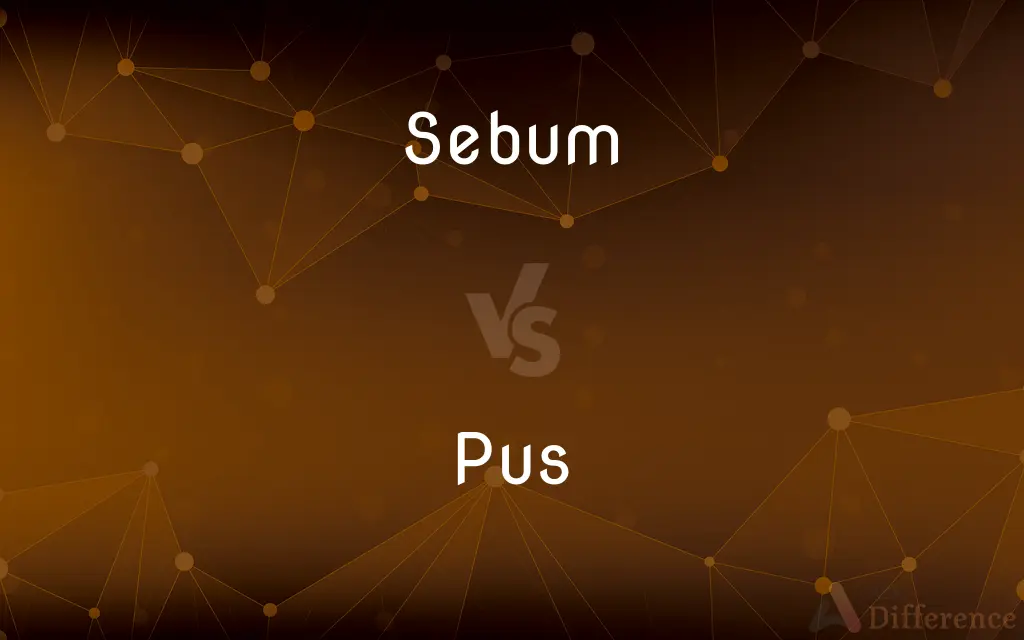Sebum vs. Pus — What's the Difference?
Edited by Tayyaba Rehman — By Urooj Arif — Updated on March 31, 2024
Sebum is an oily substance secreted by sebaceous glands to moisturize and protect the skin, whereas pus is a thick, often yellowish fluid composed of white cells, lost tissue, and bacteria, indicative of infection.

Difference Between Sebum and Pus
Table of Contents
ADVERTISEMENT
Key Differences
While sebum plays a crucial role in maintaining the health and integrity of the skin and hair by providing a protective barrier and preventing moisture loss, excess sebum production can lead to oily skin and contribute to the development of acne. In contrast, the presence of pus is an indicator of an ongoing fight against infection within the body. It signifies that the immune system is actively working to eliminate the infectious agents and debris from the site of infection.
The production of sebum is a natural and ongoing process essential for skin health, influenced by hormones, diet, and overall health. Excessive or insufficient sebum production can lead to skin problems such as acne or dermatitis. Pus, however, is not a constant presence but rather a temporary response to infection or inflammation, necessitating medical attention if persistent, as it may indicate a more serious underlying condition.
Sebum and pus also differ in their management and implications for health. Managing sebum production often involves skincare routines that regulate oil levels without stripping the skin of its natural moisture. Treatments may include gentle cleansers, moisturizers, and, in some cases, medications to balance sebum levels. Conversely, managing pus, especially in the case of infection, may require medical intervention, including antibiotics, drainage of abscesses, or other treatments to address the underlying cause of the infection and inflammation.
Despite their vastly different roles and implications, both sebum and pus are related to the skin's health and function. Sebum's protective qualities are vital for maintaining skin and hair health, while the formation of pus is a critical component of the body's defense mechanism against infection. Understanding the differences between these two substances is essential for proper skin care and recognizing when medical attention may be necessary.
Comparison Chart
Function
Lubricates and protects skin and hair
Indicates infection and immune response
ADVERTISEMENT
Origin
Sebaceous glands
Site of infection or inflammation
Health Implications
Essential for skin health; excessive production can lead to acne
Indicates an immune response to infection; may require medical treatment
Management
Skincare routines to balance oil levels
Medical intervention to treat the underlying infection
Compare with Definitions
Sebum
An oily substance secreted by sebaceous glands.
Sebum helps to keep the skin moisturized.
Pus
Found in abscesses and pimples.
Pimples often contain pus due to bacterial infection.
Sebum
Natural and essential for skin health.
Sebum plays a vital role in maintaining the skin's protective barrier.
Pus
Requires medical attention if persistent.
Persistent pus formation may need antibiotic treatment.
Sebum
Influenced by hormones.
Hormonal changes can significantly affect sebum production.
Pus
A sign of the body's defense mechanism.
The formation of pus is part of the body's response to eliminate infection.
Sebum
Protects skin and hair.
Adequate sebum production is crucial for healthy skin and hair.
Pus
A thick fluid indicative of infection.
The presence of pus signals an ongoing infection.
Sebum
Can lead to acne if overproduced.
Excess sebum is a major contributing factor to acne.
Pus
Pus is an exudate, typically white-yellow, yellow, or yellow-brown, formed at the site of inflammation during bacterial or fungal infection. An accumulation of pus in an enclosed tissue space is known as an abscess, whereas a visible collection of pus within or beneath the epidermis is known as a pustule, pimple or spot.
Sebum
The semifluid secretion of the sebaceous glands, consisting chiefly of fat, keratin, and cellular material.
Pus
(rare) To emit pus.
Sebum
(physiology) A thick oily substance, secreted by the sebaceous glands of the skin, that consists of fat, keratin and cellular debris.
Pus
The yellowish white opaque creamy matter produced by the process of suppuration. It consists of innumerable white nucleated cells floating in a clear liquid.
Sebum
The oily secretion of the sebaceous glands; with perspiration it moistens and protects the skin
Pus
The tenth month of the Hindu calendar
Pus
A fluid product of inflammation
Common Curiosities
Is pus always a sign of infection?
Yes, pus is typically a sign of infection and the body's response to fight it.
What causes sebum production to increase?
Hormonal changes, stress, and certain dietary factors can increase sebum production, leading to oily skin and acne.
Can you reduce sebum production?
Yes, sebum production can be regulated with proper skincare, diet adjustments, and, in some cases, medications.
What should you do if you have pus?
If pus is due to a minor wound or pimple, keeping the area clean is essential. If it's persistent, seek medical advice.
Does everyone produce the same amount of sebum?
No, sebum production varies among individuals and can be influenced by genetics, hormones, and environmental factors.
Can pus be prevented?
Maintaining proper hygiene and treating infections early can help prevent pus formation.
What happens if sebum is not produced adequately?
Insufficient sebum production can lead to dry, brittle hair and skin, increasing the risk of dermatitis.
What is the main difference between sebum and pus?
The main difference lies in their function and composition: sebum is a protective oily substance, while pus is a byproduct of infection fighting.
Is it bad to have sebum?
No, sebum is necessary for maintaining healthy skin and hair. Only excessive sebum production is problematic.
Can over-cleaning skin affect sebum production?
Yes, over-cleaning can strip the skin of its natural oils, leading to increased sebum production as a compensatory mechanism.
Why does pus sometimes smell bad?
The odor of pus can be attributed to the bacteria within it and the decomposition of cellular debris.
Can dietary changes affect sebum production?
Yes, diet can influence sebum production. Foods high in sugars and fats may increase sebum output in some individuals.
Is pus a good or bad sign?
While pus indicates infection, it also shows that the immune system is actively working to fight it.
How can I tell if my sebum production is normal?
Normal sebum production usually results in well-moisturized skin and hair without excessive oiliness or dryness.
What are the implications of persistent pus formation?
Persistent pus formation may indicate a severe infection or abscess that requires medical treatment, including antibiotics or drainage.
Share Your Discovery

Previous Comparison
Hematite vs. Onyx
Next Comparison
Aioli vs. RemouladeAuthor Spotlight
Written by
Urooj ArifUrooj is a skilled content writer at Ask Difference, known for her exceptional ability to simplify complex topics into engaging and informative content. With a passion for research and a flair for clear, concise writing, she consistently delivers articles that resonate with our diverse audience.
Edited by
Tayyaba RehmanTayyaba Rehman is a distinguished writer, currently serving as a primary contributor to askdifference.com. As a researcher in semantics and etymology, Tayyaba's passion for the complexity of languages and their distinctions has found a perfect home on the platform. Tayyaba delves into the intricacies of language, distinguishing between commonly confused words and phrases, thereby providing clarity for readers worldwide.













































